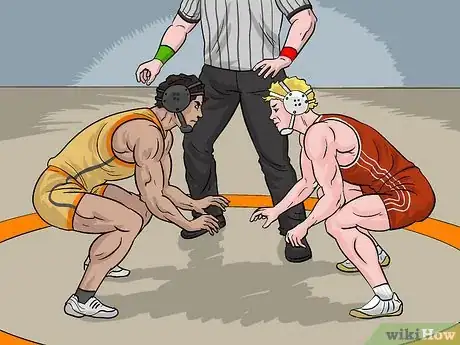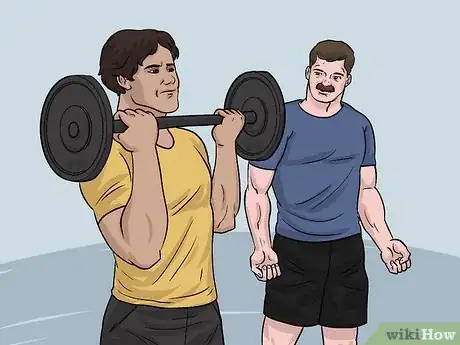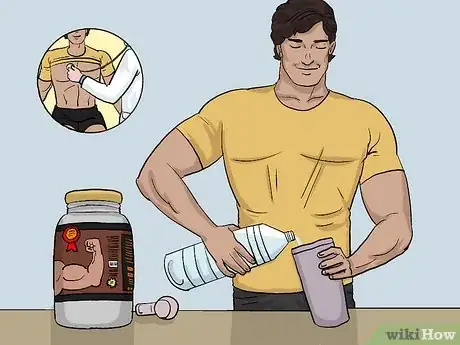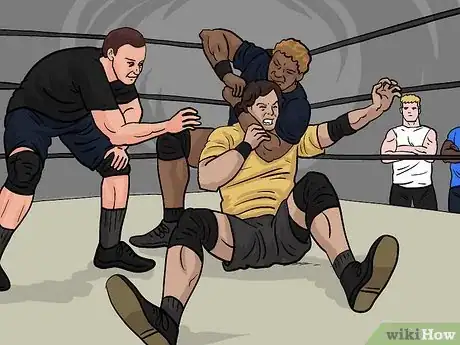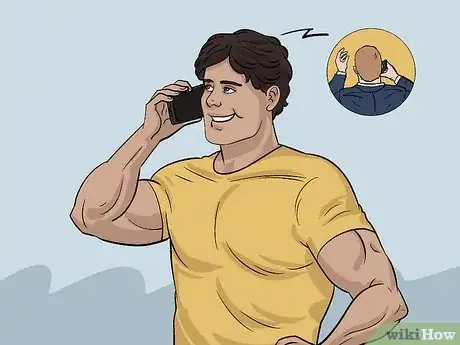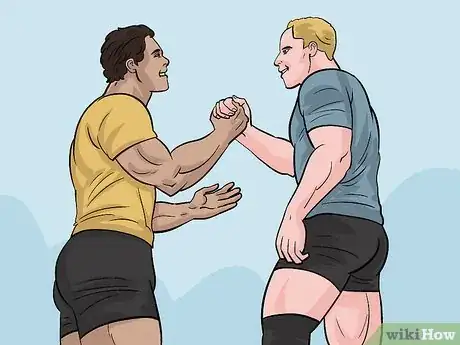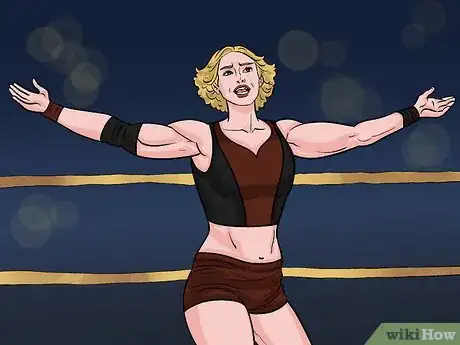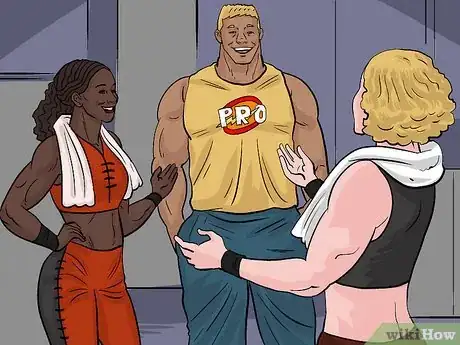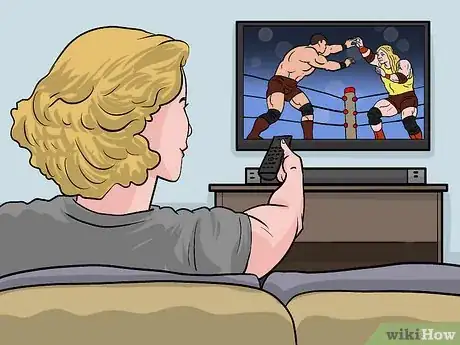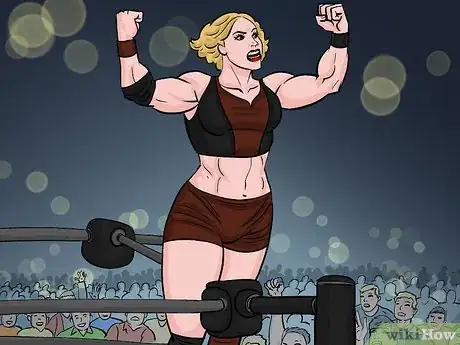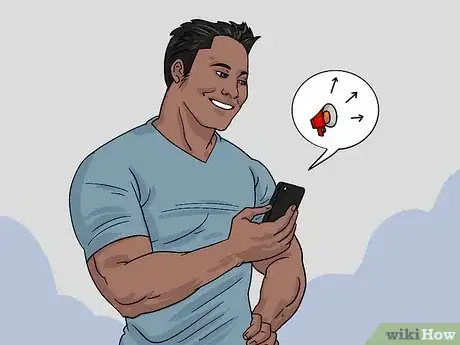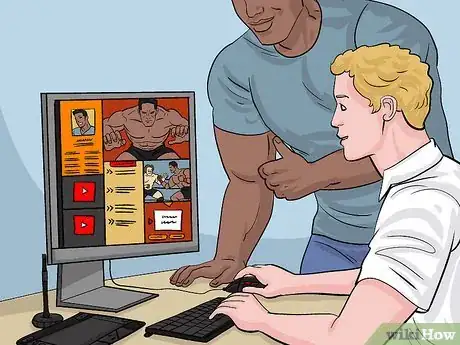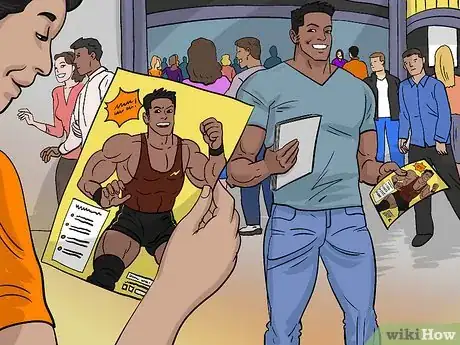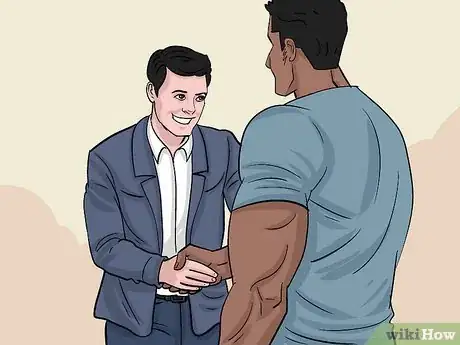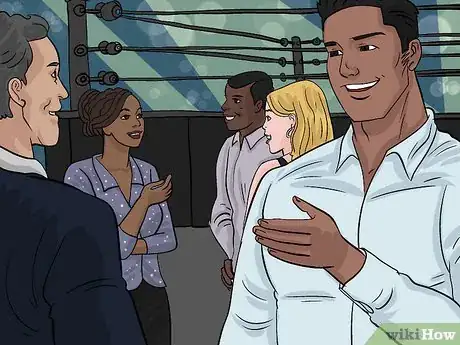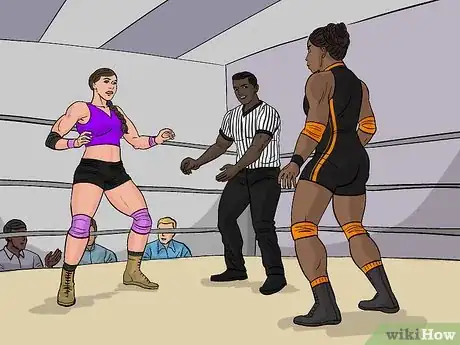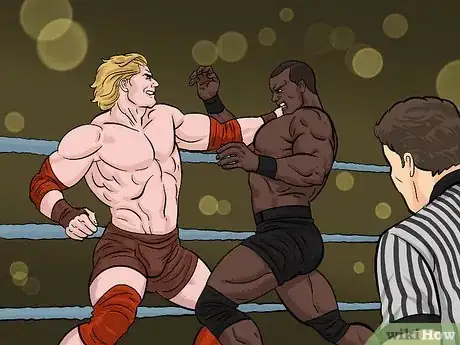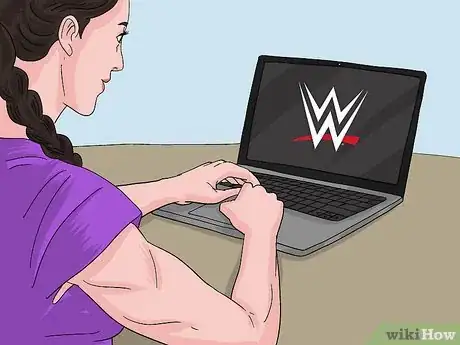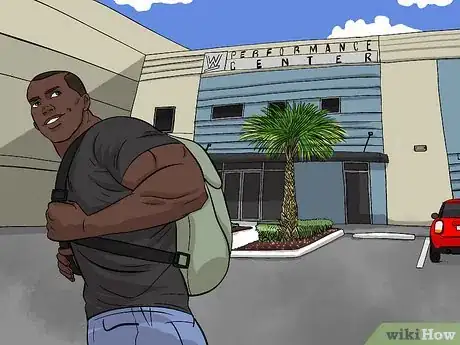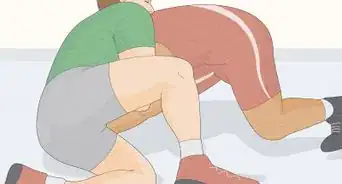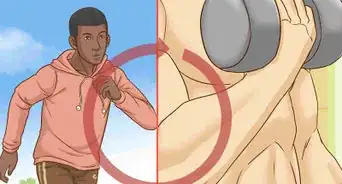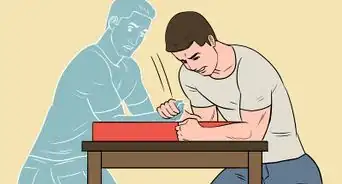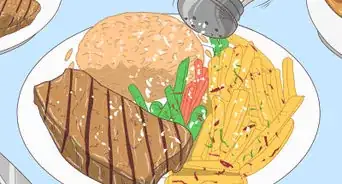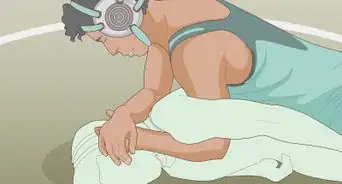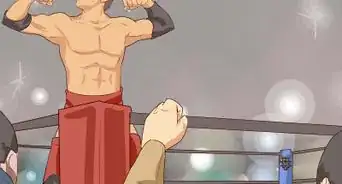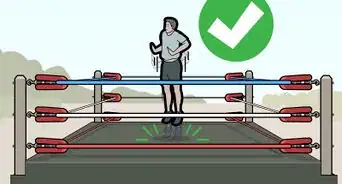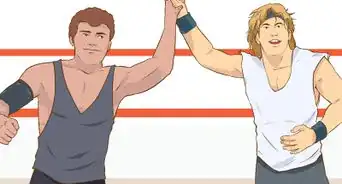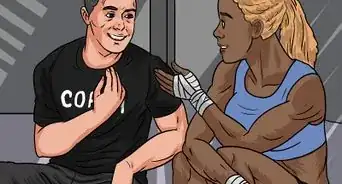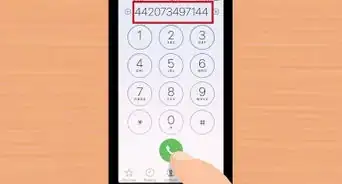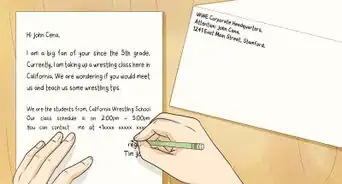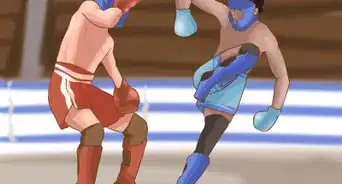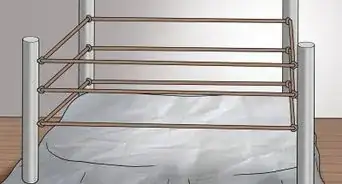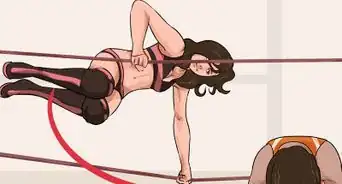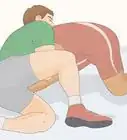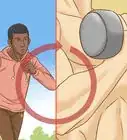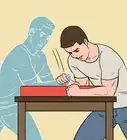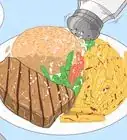This article was co-authored by wikiHow staff writer, Christopher M. Osborne, PhD. Christopher Osborne has been a wikiHow Content Creator since 2015. He is also a historian who holds a PhD from The University of Notre Dame and has taught at universities in and around Pittsburgh, PA. His scholarly publications and presentations focus on his research interests in early American history, but Chris also enjoys the challenges and rewards of writing wikiHow articles on a wide range of subjects.
There are 8 references cited in this article, which can be found at the bottom of the page.
wikiHow marks an article as reader-approved once it receives enough positive feedback. In this case, 100% of readers who voted found the article helpful, earning it our reader-approved status.
This article has been viewed 405,485 times.
Learn more...
Becoming a pro wrestler requires many of the same athletic and technical skills as those of a traditional, Olympic-style wrestler, but also has many unique aspects. Professional wrestling, for instance, emphasizes personal style and entertainment value as at least equal to wrestling skills. To be a professional wrestler, you need to develop a specific persona or character in the ring. In addition, you need to move through lower levels of the sport and eventually be accepted into organizations like the WWE (World Wrestling Entertainment). While this may seem difficult, with dedication and a lot of hard work, you'll increase your chances of becoming a professional wrestler.
Steps
Building Physical and Technical Skills
-
1Join a school wrestling team. If you’re a student in high school or college, get yourself in peak condition in time for wrestling team tryouts. Even if you’ve never wrestled before, build up your conditioning and flexibility, study and practice Olympic-style wrestling maneuvers, and show the coaches your determination to learn and improve.
- On the wrestling team, you’ll learn essential wrestling skills, be able to improve your techniques, and have the opportunity to wrestle many other people.
- In addition, you’ll be able to participate in local, regional, and possibly national competitions.[1]
-
2Hire a personal trainer for your bodybuilding program. Professional wrestlers are known for their muscular physiques, so you must build ample muscle size and definition. You can do this on your own if you’re dedicated and knowledgeable, but hiring a pro to guide and motivate you is a worthwhile investment for most aspiring wrestlers.
- Work out three to five times a week.
- Use free weights, work out with machines, and do intensive cardiovascular exercise.
- Focus on exercises like presses, lifts, curls, and pulldowns.
Advertisement -
3Take protein supplements to get more muscular. In order to build and maintain muscle, you’ll need to consume at least .8 grams (0.03 oz) of protein per pound (.45 kg) of your body weight. Even if you eat a protein-rich diet, supplementing with protein powders and similar products can help you get greater results out of your hardcore strength-building workouts.[2]
- Some wrestlers do turn to steroids and similar performance enhancers, but you should always prioritize your long-term health and safety.
- Talk to your doctor about protein supplements, as well as your ideal diet and exercise program for building muscle safely.
-
4Go to a pro wrestling training school. At a training school, you’ll be able to learn from people who formerly wrestled on the professional circuit. Before signing up, ask whether the school has had graduates who have gone on to wrestle in the WWE or another major promotion.[3]
- A class or program may cost between $1000 to $5000 (USD) per year for 2 to 4 sessions per week. Even if they offer 3 or 6 month programs, plan to stick around for 2 or 3 years if you want to make it to the big time.
- Beginner classes will focus on basic moves, cardio, and getting you into shape to perform in the ring. Intermediate classes will focus on improving your moves, learning the psychology of the ring, and pairing with someone for a match.
- Search online for schools in your area.
-
5Find a mentor or coach with professional experience. Contact wrestling coaches in your area and see if they will take you on as a mentee. Look for someone who has professional wrestling experience with the WWE or another major independent promotion. If the person doesn't have first-hand experience, you should look for someone else.[4]
-
6View your fellow wrestlers as teammates, not opponents. While other heavy-contact sports like boxing are individual affairs, wrestling is much more team-oriented. Because professional wrestling is more about entertaining than winning, you’ll need to work with your opponent to entertain the crowd. This doesn’t mean that pro wrestling is “fake.” Instead, it means that the focus is on performance rather than victory.[5]
- In pro wrestling, winning means giving the crowd a great show. And you can only do that by working with your ring opponent, rather than fighting against them.
Developing a Style and Persona
-
1Exaggerate your personality in the ring. Since wrestlers are constantly appealing to and rallying the crowd around them, it helps to embrace a demonstrative personality. Consider responding to things in a dramatic or exaggerated fashion. This way, you’ll magnify the persona that you’re developing and give the audience a unique personality to support.[6]
- Taking acting lessons or getting some experience as a performer may help you develop your persona and learn to “work the crowd.”
-
2Wrestle — and learn from — many different people. Practice or enter matches against a lot of different wrestlers. When wrestling against a more experienced person, you’ll have a chance to see their unique style up close. In addition, you’ll be able to observe their persona in the ring. This will help you hone your own character and improve your style.
- Watch and learn, but also ask lots of questions. Most seasoned wrestlers are more than willing to share tips and dish out advice (in addition to body slams!).
-
3Watch wrestling live and on television. In addition to wrestling with a lot of people, you should watch as much wrestling as you can. Whether you watch on television or in person, you’ll be able to observe how others wrestle, as well as express their style and persona. In many ways, watching wrestling is an education. After watching a lot of wrestling, you’ll be more capable of improving your own technique and performance.
-
4Transform yourself into a familiar but distinctive character. Never forget that wrestling ability means little without the development of a unique persona that can get the attention of the audience. You may want to exaggerate qualities you already possess for your ring persona, or try something completely opposite — like being boisterous and raunchy if you’re naturally soft-spoken and mild-mannered.[7]
- Your character can be very likeable or very unlikeable — the important thing is for it to be striking and memorable.
- Use the ring personas of several well-known wrestlers as a starting point, and blend them into a character that’s all your own.
Promoting Yourself
-
1Use social media to promote yourself. Create a presence on major social media outlets like Twitter, Facebook, and Instagram. Share pictures of yourself wrestling, comment on the great things other wrestlers are doing, and make as many friends as possible.[8]
- Update your social media accounts on a daily or weekly basis.
- Always be positive, unless your persona is to be negative and aggressive toward others.
- Keep with your in-ring persona or character.
-
2Create a website. One of the keys to self-promoting is establishing a good online presence. To do this, purchase a domain name with your wrestling name. Then, use a web editor or hire a web designer to create a website. Your website should include:[9]
- Pictures of you wrestling
- A short bio
- Contact information
- A resume of your in-ring experience and related achievements
- Links to your social media accounts
-
3Pass out flyers at wrestling venues, conventions, and related events. Print off flyers with your photo and wrestling name. Try to make the photos as colorful and eye-catching as possible. Your flyer should reflect the character or persona you’ve been developing in the ring. In addition to reflecting your persona, your flyer should list dates, times, and locations of where you will be wrestling in the near future.
-
4Hire an agent. An agent will be able to promote you and maybe get you some wrestling jobs. A good agent will use their contacts to get you into the best possible promotion. Without an agent, you may miss out on important opportunities.[10]
- Ask your trainers and fellow wrestlers for agent recommendations, but also make sure to choose an agent that you feel comfortable working with.
-
5Network at matches, shows, and conventions. Attend as many wrestling-related events as you can. The best events to attend are wrestling matches and shows. At these events, you’ll be able to meet professional wrestlers, agents, promoters, and others who may be able to help you or give you advice about how to move into the professional circuit.
- Focus on memorizing people’s names.
- Know who to look for. Spend time researching influential promoters and others who may be able to help advance your career.
Breaking into the Professional Circuit
-
1Audition to join an independent wrestling promotion in the United States. Wrestling promotions are private organizations that host fights. Depending on where you live, there may be a small or large promotion that you can join. Use your contacts, attend tryouts, or just try calling or emailing the promotions directly. However, be prepared to get rejected. You may need to try several promotions. Some major promotions in the U.S. include:[11]
- Ohio Valley Wrestling
- All American Wrestling
- World League Wrestling
- Texas All-Star Wrestling
- Women Superstars Uncensored
- Southern States Wrestling
-
2Join an international wrestling promotion. While the United States offers the greatest number of opportunities for prospective professional wrestlers, there are a variety of international wrestling promotions to consider as well. Some international promotions include:[12]
- Pro Wrestling Alliance Australia
- All Japan Pro Wrestling
- International Wrestling Revolution Group (Mexico)
- All-Star Wrestling (United Kingdom)
-
3Work hard to get better matches and better opponents. As you compete in matches and in circuits, always focus on moving up into higher-profile matches and better-known circuits. One way to judge this is by the fame or notoriety of the people you’re wrestling against. If you have the opportunity to wrestle someone with a big name, do so.[13]
- No matter the venue or opponent, always do your best to give the crowd a great show. Show off your skills and revel in your ring persona. You never know who might be watching.
-
4Apply to join World Wrestling Entertainment (WWE). Becoming a “WWE Superstar” is the ultimate dream of practically every pro wrestler, and of course only a select few ever achieve this lofty goal. Once you have several years of solid training, experience, and character development under your belt, create a WWE application. You’ll initially have to provide a detailed description of your background and various photos.
- You can apply online at https://recruit.wwe.com/.
-
5Relocate to Orlando, Florida. Whether you’re building up your pro wrestling resume or have already sent in a WWE application, Orlando — the WWE’s home — is the place to be. The WWE has a training center there, puts on many matches, and auditions for new talent. Because of this, there are many wrestling clubs, independent promotions, and other resources available for people interested in becoming a professional wrestler.[14]
- Other places in the United States like Louisville, Kentucky, and Las Vegas, Nevada also host relatively large professional wrestling scenes. If Florida doesn’t work for you, consider these other cities.
Community Q&A
-
QuestionWhere can I display my wrestling skills for WWE scouts?
 Community AnswerYou won't start in the big leagues. Start with your local indie company and join better companies as you go. If WWE see you as a valuable asset, they'll recruit you to start in NXT in no time.
Community AnswerYou won't start in the big leagues. Start with your local indie company and join better companies as you go. If WWE see you as a valuable asset, they'll recruit you to start in NXT in no time. -
QuestionI am 13-years-old, and I am a huge fan of wrestling. I'm just 5'5", but I'm very strong. Can you share any tips to help me improve?
 Community AnswerIf you're 13, you are still going to get taller. Don't start doing heavy weight training yet, because that might actually harm you and stunt your growth. Work on your cardio and build some muscle, but be careful about it.
Community AnswerIf you're 13, you are still going to get taller. Don't start doing heavy weight training yet, because that might actually harm you and stunt your growth. Work on your cardio and build some muscle, but be careful about it. -
QuestionHow old do I have to be to start training for wrestling?
 Community AnswerThis depends on the school. Many will only accept people 18 or older, but some will allow teenagers to train if they can show they are physically capable and can get parental permission.
Community AnswerThis depends on the school. Many will only accept people 18 or older, but some will allow teenagers to train if they can show they are physically capable and can get parental permission.
Warnings
- It’s great if you’re driven to achieve the fame and fortune of a WWE Superstar, but never forget that it’s a hard road to travel and that very few reach the ultimate destination. While some famous WWE wrestlers, like Brock Lesnar and Kurt Angle, transitioned fairly quickly from traditional to pro wrestling, many others, like The Rock and Mick Foley, spent years cleaning wrestling mats, doing side jobs like mowing lawns, and sometimes experiencing homelessness before hitting the big time.[15]⧼thumbs_response⧽
References
- ↑ https://www.collegerecruiter.com/blog/2014/08/19/want-pro-wrestler-heres-start-career-professional-wrestling/
- ↑ https://www.collegerecruiter.com/blog/2014/08/19/want-pro-wrestler-heres-start-career-professional-wrestling/
- ↑ http://www.artofmanliness.com/2009/09/02/so-you-want-my-job-professional-wrestler/
- ↑ https://www.collegerecruiter.com/blog/2014/08/19/want-pro-wrestler-heres-start-career-professional-wrestling/
- ↑ https://thetylt.com/sports/is-pro-wrestling-a-fake-sport-2
- ↑ http://www.artofmanliness.com/2009/09/02/so-you-want-my-job-professional-wrestler/
- ↑ http://www.artofmanliness.com/2009/09/02/so-you-want-my-job-professional-wrestler/
- ↑ https://www.inc.com/jason-surfrapp/5-almost-free-ways-to-promote-yourself-or-your-company-online.html
- ↑ https://www.inc.com/jason-surfrapp/5-almost-free-ways-to-promote-yourself-or-your-company-online.html
- ↑ http://www.voicesofwrestling.com/2015/09/29/bill-behrens-pro-wrestlings-power-agent/
- ↑ http://www.onlineworldofwrestling.com/promotions/independent/
- ↑ http://www.onlineworldofwrestling.com/promotions/foreign/
- ↑ https://www.collegerecruiter.com/blog/2014/08/19/want-pro-wrestler-heres-start-career-professional-wrestling/
- ↑ https://www.collegerecruiter.com/blog/2014/08/19/want-pro-wrestler-heres-start-career-professional-wrestling/
- ↑ http://www.thesportster.com/wrestling/20-wrestlers-who-were-broke-before-becoming-famous/
About This Article
If you want to become a pro wrestler, join a local or school wrestling team to learn basic wrestling moves. Work out with free weights, bodybuilding machines, and cardio exercises 3-5 times a week to build your muscles, and take protein supplements to build even more muscle. You may also want to join a training school for wrestlers for about 2-3 years to help you develop the skills you’ll need. As you progress, try to develop a unique style and persona that helps you create a distinctive character, since this will make audiences remember you. For tips on hiring a coach or mentor, keep reading!
